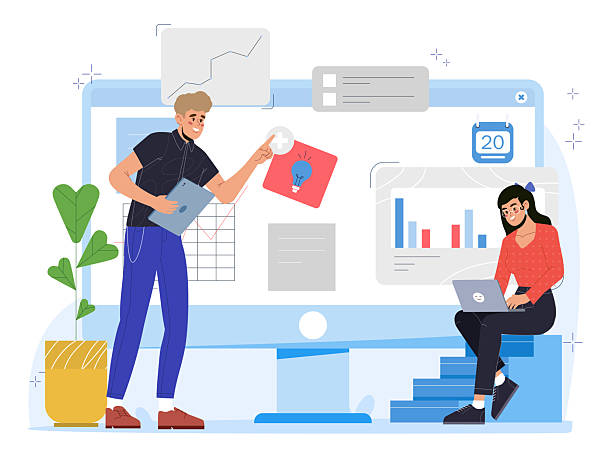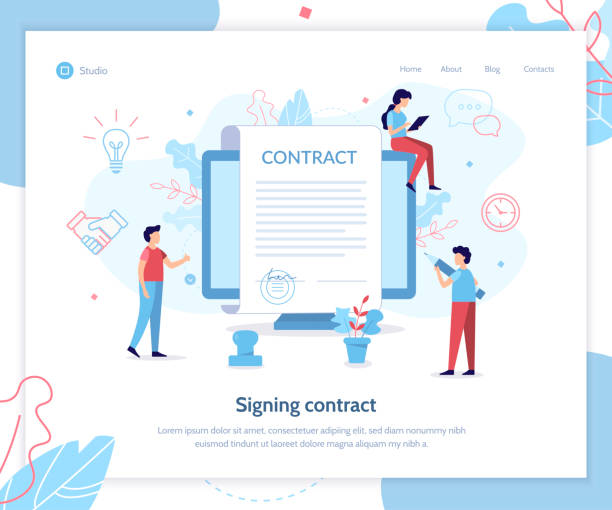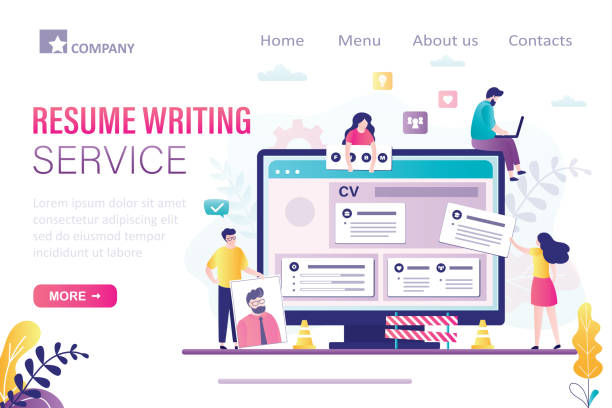An Introduction to Rapid Website Design and Its Importance in the Present Era

In today’s world, where speed is paramount, rapid website design is no longer a competitive advantage, but a necessity.
Internet users have high expectations, and any delay in page loading can mean losing visitors and customers.
This chapter, in an explanatory and educational manner, elucidates the concept of site speed and its importance in user experience and SEO.
When speaking of rapid website design, it refers not only to initial loading speed but also to overall website responsiveness, smooth user interactions, and the loading time of all content.
Research has shown that most users wait only a few seconds for a page to load, after which they leave the site.
These exits not only increase your website’s Bounce Rate but also negatively impact its ranking in search engines like Google.
Therefore, a high-speed website not only brings user satisfaction but also significantly helps improve SEO (Search Engine Optimization) and, consequently, increases your website’s visibility.
Beyond technical aspects, site speed directly influences users’ perception of your brand’s professionalism and credibility.
A slow site often appears unreliable and outdated, even if it contains very valuable content.
In contrast, a high-speed website conveys a sense of efficiency and trust, which is vital for any business.
This issue is doubly important for e-commerce websites; every second of delay can mean significant lost sales.
Understanding these aspects is the starting point for any high-speed website design project.
Is your company’s website as professional and trustworthy as it should be? With specialized corporate website design by Rasaweb, create an online presence that reflects your credibility and attracts more customers.
✅ Build a powerful and professional image for your brand
✅ Convert visitors into real customers
⚡ Get a free consultation now!
Why is Website Speed Crucial for Your Business?

Website speed is one of the most important factors in the success of online businesses and has a profound impact on Google ranking, conversion rates, and user experience.
This section provides an analytical and thought-provoking examination of these impacts.
Did you know that Google uses page speed as one of its ranking factors? This means that slower websites may rank lower in search results, even if they have quality content.
This is a fundamental question every business owner should ask themselves: Is my website’s speed hindering my business’s visibility and growth? In addition to SEO, site speed directly affects sales increase and Conversion Rate.
The longer the loading time, the more likely users are to abandon your site and go to your competitors.
In fact, studies show that with every second of delay in page loading, the conversion rate can decrease by up to 7 percent.
This is an alarming statistic for any business seeking more visitors and revenue.
User Experience (UX) is also heavily influenced by site speed.
Today’s users seek a smooth and uninterrupted user experience.
A slow website can lead to frustration, anger, and ultimately, users leaving the site.
This negative experience can damage your brand’s reputation and even reduce customer loyalty.
Investing in rapid website design is, in fact, an investment in the future of your business.
This investment means increased traffic, improved SEO, higher conversion rates, and ultimately, sustainable revenue growth.
Understanding these analytical dimensions helps you see the importance of speed beyond a mere technical issue and consider it a core pillar of your digital strategy.
Technical Optimization for Rapid Website Design

To achieve rapid website design, special attention must be paid to its technical aspects.
This section, in a specialized and guiding manner, addresses three main pillars of technical optimization: server response time, code optimization, and database.
Server Response Time is one of the first things search engines and users pay attention to.
A slow server can impact the entire website experience.
Factors such as hosting quality, server settings, and allocated resources are crucial in this regard.
Choosing a reputable hosting provider that fits your website’s needs is the first step to improving server response time.
Furthermore, code optimization involves the Minification of HTML, CSS, and JavaScript files.
Removing extra spaces, comments, and characters from these files significantly reduces their size, allowing browsers to download and process them faster.
This process of optimal coding optimization is essential for achieving the best performance.
Also, using CSS Sprites to combine small images and reduce HTTP requests, or Asynchronous Loading of scripts, can help improve speed.
Finally, database optimization plays an important role in the speed of Dynamic Websites.
Removing redundant data, optimizing queries, and proper table indexing can drastically reduce information retrieval time.
For websites that manage a large volume of content or users, this aspect of optimization is particularly important.
Following these specialized guidelines lays the foundation for a high-speed website.
Table 1: Comparison of Hosting Types for Speed
| Hosting Type | Suitable For | Speed and Performance | Approximate Cost |
|---|---|---|---|
| Shared Hosting | Small and nascent websites | Variable, often slower | Low |
| Virtual Private Server (VPS) Hosting | Medium websites with growing traffic | Good, more stability | Medium |
| Dedicated Server | Large websites with high traffic | Excellent, full control | High |
| Cloud Hosting | Dynamic websites with flexibility needs | Very good, scalable | Variable, based on usage |
The Role of Images and Media in Site Loading Speed

Images and media files often constitute the largest part of a website’s size and can severely impact loading speed.
This chapter, in an educational and explanatory manner, discusses techniques for image and media file optimization to contribute to rapid website design.
One of the most important steps is using appropriate image formats.
New formats like WebP, compared to JPEG or PNG, can store images with similar quality at significantly smaller sizes.
This is an effective compression that increases loading speed without a noticeable loss in visual quality.
After choosing the right format, compressing images without a noticeable quality reduction is the next step.
Numerous online tools and plugins are available for this purpose that can significantly reduce image sizes.
Also, resizing images to the exact dimensions displayed on the website is very important.
Loading a large image and then shrinking it with CSS only leads to an unnecessary increase in page size.
Another highly recommended technique is Lazy Loading.
Using this method, images and videos are only loaded when the user scrolls to the relevant section of the page.
This significantly reduces initial page load time, especially on long pages with many images, and helps improve user experience.
Finally, using Responsive Images, which provide different versions of an image based on the user’s screen size, ensures that mobile users do not download large and unnecessary images.
Adhering to these tips are fundamental steps in reducing page size and building a high-speed website.
Does your current corporate website present a worthy image of your brand and attract new customers?
If not, turn this challenge into an opportunity with Rasaweb’s professional corporate website design services.
✅ Significantly improves your brand’s credibility and image.
✅ Paves the way for attracting new leads and customers for you.
⚡ Contact Rasaweb now for a free and specialized consultation!
Caching and CDN (Content Delivery Network) for Rapid Website Design

Caching and Content Delivery Network (CDN) are two powerful tools that play a pivotal role in rapid website design.
This section provides a specialized and guiding explanation of how they work and the benefits of using them.
Caching means temporarily storing website data closer to the user or on the server so that in subsequent visits, there is no need to reload from the origin.
This process is divided into two main types: browser cache and server cache.
Browser cache allows the user’s browser to store static files such as CSS, JavaScript, images, and fonts.
When the user returns to your site, these files are loaded from the browser’s cache instead of being downloaded again, which significantly increases speed.
Server cache also stores data generated by the server (such as dynamic HTML pages) to be presented to the user in subsequent requests without the need for re-processing.
This helps reduce server load and improve response time.
Using caching plugins in content management systems like WordPress makes implementing these features very easy.
On the other hand, CDN (Content Delivery Network) or content distribution, is a network of servers scattered across various geographical locations.
The main goal of a CDN is to store copies of your website’s static content (such as images, videos, CSS, JS) on these servers.
When a user visits your website, the CDN delivers the content from the server closest to the user’s geographical location.
This not only reduces the physical distance for data transfer but also lessens the load on your main server, making your website load much faster for users worldwide.
Choosing a suitable CDN, such as Cloudflare or ArvanCloud, can make a significant difference in your website’s performance and help you maintain a high-speed website design.
The correct combination of caching and CDN forms the backbone of a fast and stable website.
The Impact of Responsiveness on Speed and Mobile User Experience

In the current era, a significant portion of web traffic originates from mobile devices.
Therefore, not only is Responsive Design crucial for the correct display of a site across various screen sizes, but its impact on speed and mobile user experience is also highly significant.
This chapter, in an analytical and educational manner, examines this relationship and solutions for its improvement.
Google has long emphasized Mobile-First Indexing, meaning that your site’s mobile version is Google’s primary basis for indexing and ranking.
A responsive website that loads quickly on mobile automatically gains a higher SEO score.
But how can a responsive design help improve speed? Proper responsive design should prevent the loading of unnecessary resources for mobile devices.
For instance, high-resolution images optimized for desktop should not be loaded in the same way for mobile.
Using CSS features like `media queries` and responsive images (using `srcset` and `sizes`) helps the browser download only the necessary resources for the current screen size.
This directly impacts rapid website design.
Furthermore, technologies like AMP (Accelerated Mobile Pages) are specifically designed to deliver web content with incredible speed on mobile.
AMP loads pages almost instantly by removing unnecessary code and utilizing Google’s cache.
This feature is particularly useful for news and content websites that aim to provide information quickly to mobile users.
AMP might not be suitable for every website, but it is a powerful option when mobile loading speed is the top priority.
Finally, focusing on mobile efficiency, including file minification, font optimization, and utilizing mobile browser capabilities, not only improves user experience but also helps you achieve SEO and conversion rate goals.
A principled responsive design is a significant step towards building a high-speed website.
Speed Measurement Tools and Result Interpretation

After implementing optimization techniques, the next step is to measure performance and ensure the achievement of rapid website design.
This chapter, in a guiding and specialized manner, introduces reliable speed testing tools and how to interpret their results.
The three main tools widely used for website speed evaluation are: Google PageSpeed Insights, GTmetrix, and Pingdom Tools.
Each of these tools uses specific criteria for scoring and providing recommendations, offering different perspectives on your website’s performance.
Google PageSpeed Insights provides a performance score for your site’s mobile and desktop versions based on Google’s Core Web Vitals (including LCP, FID, CLS) and other technical factors.
This tool offers specific recommendations for speed improvement, including image optimization, reducing server response time, and eliminating render-blocking JavaScript and CSS.
GTmetrix also provides a comprehensive report on website performance, which includes full load time, page size, and number of requests.
This tool uses two metrics, Yahoo! YSlow and Google PageSpeed, and provides actionable recommendations for performance improvement along with technical details.
Pingdom Tools is another tool that provides useful information about the loading time of various page elements, such as images, scripts, and CSS files, helping you identify bottlenecks.
For optimal use of these tools, it’s important to pay attention not only to the final score but also to the details of the report and the recommendations provided.
Every recommendation made for improving site speed should be carefully reviewed and implemented if possible.
By regularly monitoring performance and continuously implementing improvements, you can ensure that your website always operates at high speed.
Table 2: Website Speed Analysis Tools and Features
| Tool Name | Main Focus | Main Metrics | Special Features |
|---|---|---|---|
| Google PageSpeed Insights | SEO and User Experience | Core Web Vitals | Separate mobile and desktop reports |
| GTmetrix | Overall and detailed performance | PageSpeed Score, YSlow Score | Waterfall chart, loading video |
| Pingdom Tools | Load time and element details | Load Time, Page Size, Requests | Heatmaps, testing from various locations |
Common Mistakes That Reduce Your Website Speed

Even with the best intentions for rapid website design, there are mistakes that can inadvertently reduce your website’s speed.
This chapter, in a thought-provoking and explanatory manner, examines common mistakes so you can avoid them.
Did you know that excessive use of plugins can be one of the biggest obstacles to your website’s speed? Every plugin you install adds to server resources, HTTP requests, and JavaScript and CSS codes, all of which can increase loading time.
Many plugins have unnecessary or heavy codes that are difficult to optimize.
So, the question is: Do you really need all these numerous plugins? The best approach is to use the minimum number of essential plugins and choose lightweight and optimized ones.
Also, your website’s theme can play a significant role in speed.
A heavy theme full of unnecessary features can slow down your website even before installing any plugins.
Choosing a lightweight and speed-optimized theme from the outset is very important.
Another often overlooked factor is external scripts such as tracking codes or advertisements.
These scripts can have long loading times and even impact your website’s speed if their own servers are slow.
Optimizing the loading of these scripts and ensuring they load asynchronously can be helpful.
High-volume media files also remain a common problem.
As mentioned in the previous chapter, optimizing images and videos is essential.
Uploading images with high dimensions and quality that are used without compression severely reduces site speed.
Finally, regular database cleanup and removal of unnecessary data (such as old draft post versions and spam comments) also help maintain your website’s speed.
Avoiding these common mistakes is a fundamental step in ensuring a high-speed website.
Tired of losing customers due to poor e-commerce website design? With Rasaweb, solve this problem permanently!
✅ Increase sales and visitor-to-customer conversion rates
✅ Smooth and attractive user experience for your customers⚡ Get a free consultation
Maintenance and Updates for Sustaining Stable Speed

Achieving rapid website design is not a one-time process but requires continuous maintenance and updates.
This chapter, in an educational and guiding manner, addresses the importance of continuous updates and methods for sustaining stable speed.
One of the most crucial aspects of website maintenance is regularly updating the Content Management System (CMS), theme, and all plugins.
Developers continuously release new versions that include performance improvements, bug fixes, and security updates.
Failure to update can not only expose your site to security vulnerabilities but also cause a decrease in speed, as older versions may not align with new web standards.
A regular plan for website speed monitoring, using the tools previously introduced, helps you quickly identify and resolve any speed drops.
These monitoring efforts should be periodic and continuous, not just after major changes.
In addition to updates, regular database cleanup is also crucial for maintaining speed.
Over time, the database can become filled with unnecessary data such as old draft post versions, spam comments, temporary information, and log entries.
Optimizing and cleaning this data improves database performance and reduces server response time.
Furthermore, periodic review of website codes and scripts, especially excessive JavaScript or old CSS files that are no longer used, can help remove extra load and increase speed.
Finally, website security is also related to speed.
A compromised or cyber-attacked website is not only unsafe for users but also experiences a significant performance degradation.
Therefore, implementing strong security measures and regular malware scans are an integral part of website maintenance that helps maintain its speed and stability.
Adhering to these maintenance principles ensures that your site always remains a high-speed website.
The Future of Rapid Website Design and Emerging Trends

The world of web is constantly evolving, and with it, the need for rapid website design also becomes more advanced.
This chapter, in a news-oriented, analytical, and engaging manner, explores emerging trends and what is expected for website speed optimization in the future.
One of the most important trends emphasized by Google is the concept of Web Vitals.
Core Web Vitals (including Largest Contentful Paint, First Input Delay, Cumulative Layout Shift) are metrics that Google uses to evaluate real-world user experience and influence website rankings in search results.
Familiarity with and optimization for these metrics will be crucial for every website in the future, and it can be considered a key aspect of building a high-speed website.
This news alerts all website owners that merely numerical speed is not enough; user experience in interacting with the site is also important.
Artificial Intelligence (AI) is also entering the field of web performance optimization.
Artificial Intelligence can automatically compress images, optimize codes, and even predict and manage server load.
This technology has great potential for automating many complex speed optimization processes and can make rapid website design much easier in the future.
Another important development is the transition from HTTP/2 to HTTP/3.
HTTP/3, built upon the QUIC protocol, offers significant improvements in web communication performance and security, especially in unstable and mobile networks.
This new protocol can help reduce latency and increase data transfer speed.
Serverless Architecture and Edge Computing are also emerging trends that enable code execution closer to the user and reduce response time.
These technologies allow developers to build very fast and scalable web applications without worrying about server management.
These developments indicate that the path of rapid website design is full of innovation and new opportunities to provide an unparalleled user experience.
Frequently Asked Questions
| Row | Question | Answer |
|---|---|---|
| 1 | What does rapid website design mean? | Rapid website design means optimizing website design and development processes so that the final product (website) is ready for use in the shortest possible time, while maintaining quality and efficiency. This includes using efficient tools, templates, and techniques. |
| 2 | Why is speed important in website design? | Speed in website design is important because customers usually have an immediate need for an online presence. Also, longer projects can be more costly and delay business opportunities. Faster website delivery contributes to customer satisfaction and competitive advantage. |
| 3 | What tools help with rapid website design? | Content Management Systems (CMS) such as WordPress, Joomla, or Drupal, using CSS frameworks like Bootstrap or Tailwind CSS, Page Builders like Elementor or Visual Composer, and Rapid Application Development (RAD) tools help with rapid design. |
| 4 | Does using ready-made templates affect rapid design? | Yes, using ready-made and standard templates has a very significant impact on rapid design. These templates are pre-designed and only require customization of content, color schemes, and images, which drastically reduces development time. |
| 5 | What is the role of CMS (Content Management System) in rapid website design? | CMSs play a key role in accelerating the website design and development process due to providing a graphical user interface, no need for deep coding for most operations, the availability of plugins and ready-made templates, and the ease of content editing. |
| 6 | Does high design speed reduce the final website quality? | No, not necessarily. If standard and optimized methods, tools, and templates are used, a high-quality website can be designed in a short time. The knowledge and experience of the design team are also very effective in maintaining quality. |
| 7 | What tips are important for accelerating the customer communication process in website design? | Having a clear and defined process for requirements gathering, using standard forms for content submission, setting realistic deadlines, and holding focused and efficient meetings can accelerate communication with the customer. |
| 8 | What is the effect of image optimization on website loading speed after design? | Image optimization (reducing size, using suitable formats like WebP) decreases the overall size of website pages. This reduction helps browsers download and display pages faster, which improves user experience. |
| 9 | Is suitable hosting effective in the final website speed after design? | Yes, high-quality hosting, powerful servers, sufficient resources, and adequate bandwidth play a very important role in website loading speed after design. Even an optimized website will perform slowly on weak hosting. |
| 10 | What types of businesses are best suited for rapid website design? | Rapid website design is very suitable for small and medium-sized businesses, startups, nascent online stores, bloggers, or individuals who need an immediate and low-cost online presence. This method allows them to enter the market faster and receive feedback. |
And other services of Rasa Web Advertising Agency in the field of advertising
Smart Direct Marketing: A blend of creativity and technology for customer acquisition through intelligent data analysis.
Smart Sales Automation: Revolutionize digital branding with the help of attractive UI design.
Smart Google Ads: Designed for businesses seeking campaign management through SEO-driven content strategy.
Smart UI/UX: Designed for businesses aiming to increase website traffic through precise audience targeting.
Smart Website Development: Transform sales growth with the help of user experience customization.
And over a hundred other services in the field of online advertising, advertising consultation, and organizational solutions.
Online Advertising | Advertising Strategy | Advertorials
Sources
Article: Rapid Website Design and Its Advantages
Blog: Why is Site Speed Crucial for Your Business?
Tutorial: Website Loading Speed Optimization Techniques
Guide: The Role of Hosting in Your Website Speed
📍 Rasaweb Afarin Digital Marketing Agency, your strategic partner on the path to online brilliance and sustainable business growth. Keep your brand at its peak with our professional services in SEO-optimized website design and digital marketing.
📍 Tehran, Mirdamad St., next to Central Bank, Southern Kazeroun Alley, Ramin Alley, No. 6



